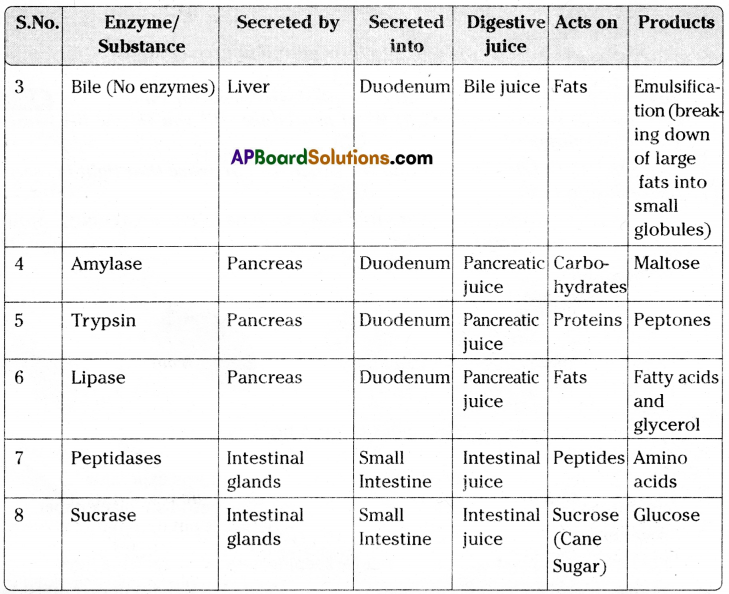Telangana SCERT 10th Class Biology Study Material Telangana 1st Lesson Nutrition Textbook Questions and Answers.
TS 10th Class Biology 1st Lesson Questions and Answers Telangana – Nutrition
Question 1.
Write differences between
a. autotrophic nutrition – heterotrophic nutrition
b. Ingestion – digestion
c. Light reaction – dark reaction
d. Chlorophyll – chloroplast
Answer:
a.
| Autotrophic Nutrition | Heterotrophic nutrition |
| 1. It means that the organism prepare its own food and is not dependent on any other organism. | 1. It means that the organism does not prepare its own food and is dependent on other organisms for food. |
| 2. Food is prepared from CO2 water and sunlight. | 2. Food cannot be prepared from CO2 water and sunlight. |
| 3. Green plants and certain bacteria have autotrophic mode of nutrition. | 3. All the animals and fungi, most bacteria have heterotrophic mode of nutrition |
b.
| Ingestion | Digestion |
| Taking in of food through mouth is called Ingestion. | Breaking up of complex molecules of food into simple and small molecules is called digestion. |
c.
| Light reaction | Dark reaction |
| 1. Occurs in the grana of the chloroplast. | 1. Occurs in the stroma of the chloroplast. |
| 2. Occurs only in the presence of light. | 2. It is not dependent on light. |
| 3. End products are O2, ATP and NADPH. | 3. End product is Glucose |
| 4. This is also called as light dependent reaction. | 4. This is also called as light independent reaction. |
d.
| Chlorophyll | Chloroplast |
| 1. Chlorophyll is a pigment of green colour. | 1. Chloroplast is a membraneous structure. |
| 2. It contains one atom of magnesium. | 2. It consists of 3 membranes. |
| 3. It harvests solar energy and convert into chemical energy. | 3. It is responsible for enzymatic reactions leading to the synthesis of glucose. |
![]()
Question 2.
Give reasons
a. Why photosynthesis is considered as the basic energy source for most of living world?
b. Why is it right to call the dark phase of photosynthesis as a light independent phase?
c. Why is it necessary to destarch a plant before performing any experiment on photosynthesis?
d. Why is not possible to demonstrate respiration in green plant kept in sun light?
Answer:
a. All living things constantly need energy to be alive. They get the energy in the form of food. The food directly or indirectly comes from the green plants through photosynthesis. Hence photosynthesis can be considered as the basic energy source for most of living world.
b. The term dark reaction does not mean that they occur when ills dark at night. It only means that the reactions are not depend on light. Hence we call the dark phase of photosynthesis as a light independent phase.
c. It is necessary to destarch a plant before performing any experiment on photosynthesis because if starch is present it may interfere with the result of the experiment.
d. We cannot demonstrate an experiment of respiration in green plants because if sunlight is present, the CO2 produced in respiration will be used in photosynthesis. So we must conduct an experiment on respiration in green plants in a dark room.
Question 3.
Give examples
a. Digestive enzymes
b. Organisms exhibiting heterotrophic nutrition
c. Vitamins
d. Nutritional deficiency diseases
Answer:
a. Digestive enzymes
Eg : Amylase (ptyaÌin), Pepsin, Trypsin, Lipase, Peptidases, Sucroses, Chymotrypsin, Nucleases, Lactose, Nucleotidases and Nucleosidases are the examples for digestive enzymes.
b. Organisms exhibiting heterotrophic nutrition
Eg: Animals : Lice, leeches and tapeworms.
Plants : Cuscuta, bread moulds, yeast, mushrooms etc.
![]()
c. Vitamins
Eg: Water soluble vitamins: B Complex (Niacin – B6, Thiamine – B1) and vitamin C.
Fat soluble vitamins: Vitamin A, D, E, K
A: Retinol
D: Calciferol
E: Tocoferol
K: Phylloquinone
d. Nutritional deficiency diseases
Eg: Kwashiorkor, Marasmus, etc.
Question 4.
From where do plants get the raw materials required for photosynthesis?
Answer:
| Raw materials for photosynthesis | Source |
| Carbon dioxide | Atmosphere |
| Water | Ground |
| Solar energy | Sun |
| Chlorophyll | Leaf |
Question 5.
Explain the process of photosynthesis in with the help of a flow chart?
Answer:
Process of photosynthesis:
1. The chemical equation representing the process of photosynthesis is
![]()
2. Photosynthesis may be defined as a photochemical reaction, during which carbohydrates are formed from carbon dioxide and water in the chloroplasts of the green plants in presence of sunlight.
3. Carbon dioxide, water, light and chlorophyll are essential requirements for photosynthesis.
4. Glucose, oxygen and water are the products of the reaction. Oxygen is released into the atmosphere.
5. In the process of photosynthesis, the low energy substances like carbon dioxide and water are converted to high energy compounds like glucose.

Question 6.
Name three end products of photosynthesis?
Answer:
Glucose, oxygen and water are the three end products of photosynthesis.
Question 7.
What is the substance that connects light reaction and dark reaction?
Answer:
ATP (Adenosine Tri Phosphate) and NADPH (Nicotinamide Adenosine Dinucleotide Hydrogen Phosphate) are the connecting substances between light reaction and dark reaction.
Question 8.
In most of leaves the upper surface will be more green and shiny than the lower surface. Why?
Answer:
The upper surface is more green and shiny than the lower ones because the upper surface comprising of the palisade parenchyma has more number of chloroplasts than the spongy parenchyma in the lower surface.
![]()
Question 9.
Explain the structure of chloroplast with a neatly labeled sketch.
Answer:
- In green plants there are special membrane-bound organelles called chloroplasts.
- Chloroplasts occur mainly in the mesophyll cells of leaves.
- Typical chloroplasts are disc-shaped and consist of three membranes.
- The third layer that forms stacked sac-like structures is called grana. It is the site for trapping of solar energy.
- In the chloroplast there is fluid-filled portion called stroma, responsible for enzymatic reactions leading to the synthesis of glucose, which in turn join together to form starch.
- These chloroplasts are green in colour because of a pigment called chlorophyll.
- The chlorophyll and other pigments of the chloroplasts are fat soluble and are located in the liquid part of the thylakoid membrane.
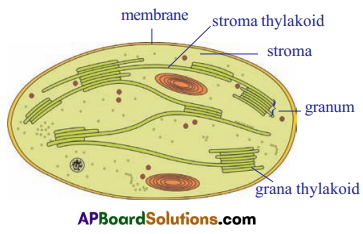
Question 10.
What is the role of acid in stomach?
Answer:
- HCl found in stomach helps in killing harmful germs which may have come along with the food.
- Hydrochloric acid creates an acidic medium which facilitates the action of enzyme pepsin.
- Pepsin is active in the presence of hydrochloric acid.
Question 11.
Mention the names of glands and organs which help in digestion?
Answer:
The names of glands and organs which help in digestion are :
- Salivary glands
- Gastric glands
- Liver
- Pancreas
- Intestine glands
Question 12.
How is the small intestine designed to assimilate the food? explain.
Answer:

- The small intestine is the main region for absorption of digested food.
- The inner surface of small intestine has millions of tiny finger-like projections called villi.
- Due to the presence of villi, the absorbing surface area of small intestine increases.
- And the large surface area of small intestine helps in the rapid absorption of digested food.
- The digested food which is absorbed through the walls of the small intestine, goes into our blood.
- Rest of the undigested food material passes to the large intestine.
![]()
Question 13.
How are fats digested? Where do they get digested?
Answer:
Digestion of fats in our body :
- Bile juice secreted by liver emulsifies large fat globules into small fat globules.
- Lipase of pancreatic juice breaks down small fat globules.
- The enzyme present in intestinal juice breaks down fats into fatty acids and glycerol.
- The process of digestion of fats takes place in small intestine.
Question 14.
What is the role of saliva in the digestion of food?
Answer:
- Saliva is secreted by three pairs of salivary glands present in the mouth.
- Human saliva contains an enzyme called amylase (ptyalin) that converts starch into maltose (a sugar).
- The food is mixed thoroughly with saliva and moved around the mouth while chewing by the muscular tongue.
Question 15.
What will happen to protein digestion as the medium of intestine is gradually rendered alkaline?
Answer:
- The food coming from the stomach to intestine is acidic in nature.
- Bile and pancreatic juices render the internal condition of the intestine gradually to a basic or alkaline one.
- In the alkaline medium, pancreatic enzyme trypsin can act on the food and digests the proteins.
- The enzymes present in the intestinal juice complete the digestion of proteins into amino acids.
Question 16.
What is the role of roughages in the alimentary tract?
Answer:
- Roughages are the fibres of either carbohydrates or proteins.
- They keep a person healthy by keeping the intestine working and moving other food quickly through the alimentary canal.
Question 17.
What is malnutrition? Explain few nutritional deficiency diseases ?
Answer:
Eating of food that does not have one or more than one nutrients in required amount is known as malnutrition. Poor health, willful starvation,lack of awareness of nutritional habits, socio-economic factors are all the reasons for malnutrition.
Malnutrition is of three types :
- Calorie malnutrition,
- Protein malnutrition,
- Protein calorie malnutrition.
Kwashiorkor disease : This is due to protein deficiency in diet. Body parts become swollen due to accumulation of water in the intercellular spaces. Very poor muscle development,swollen legs, fluffy face, difficult to eat, diarrhoea, dry skin are the symptoms of this disease.
Marasmus : This is due to deficiency of both proteins and calories. Generally this disease occurs when there is an immediate second pregnancy or repeated child births. Lean and weak, swelling limbs, less developed muscles, dry skin,diarrhoea, etc. are the symptoms of this disease.
Obesity : This is due to over-eating and excess of energy intake. It is a big health hazard. Obese children when grow, they will be target of many diseases like diabetes, cardio vascular, renal, gall bladder problems.
![]()
Question 18.
How do fungi and bacteria obtain their nourishment?
Answer:
- Bacteria and fungi are non-green plants. So they cannot prepare their own food materials.
- They are saprophytes which feed on dead and decaying plant and animal bodies
- The fungi and bacteria breakdown the complex organic molecules present in dead and decaying matter and convert them into simpler substances outside the body
- These simpler substances are then absorbed by fungi and bacteria as their food.
Eg : Saprophytic bacteria, Rhizobium.
Question 19.
If we keep on increasing CO2, concentration in air what will happen to the rate of photosynthesis?
Answer:
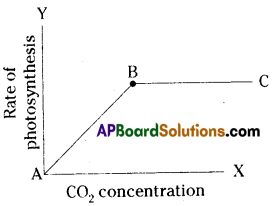
- The rate of photosynthesis increases as the concentration of CO2, increases in the air.
- Gradually the rate of photosynthesis falls and at a certain CO2, concentration the rate of photosynthesis stays constant.
- Here a rise in CO2 levels has no affect on the rate of photosynthesis as the other factors such as light intensity become limited.
Question 20.
What happens if the rate of respiration is more than the rate of photosynthesis in a plant?
Answer:
- Respiration is a catabolic (destructive) process and photosynthesis is an anabolic (constructive) process.
- In catabolic process bigger molecules are broken down into smaller molecules like the glucose molecule into water and carbon dioxide as in respiration.
- In anabolic process like photosynthesis simple molecules like CO2 and water are converted into complex carbohydrate molecules.
- Both constructive and destructive process must occur in a plant for its normal growth.
- If respiration overtakes photosynthesis (constructive) in a plant it is starved off from the supply of food and thereby it gets etiolated and finally it leads to the death of the plant.
Question 21.
How can you say that the carbohydrates are not completely digested until they reach the intestine?
Answer:
- For the digestion of carbohydrates, enzyme ptyalin or amylase are required.
- The gastric juice produced by stomach do not contain the enzyme ptyalin or amylase It contains only pepsin which digests proteins.
- Hence carbohydrates are not digested in the stomach.
- Carbohydrates are digested partially in the mouth and completely in small intestine.
Question 22.
What process do you follow in the laboratory to study the presence of starch in leaves?
Answer:
Apparatus required: Tripod stand, beaker, test tube, water, spirit Iamp/ bunsen Durner,petridish methylated spirit dropper, Iodine.
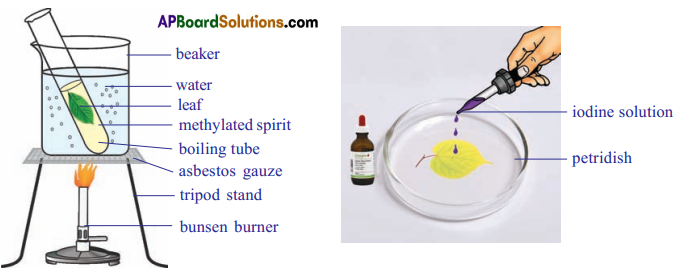
Procedure :
- Take a leaf of a plant which has soft and thin leaves and well exposed to sunlight.
- Boil the leaf in methylated spirit over a water bath till it becomes pale – white due to the removal of chlorophyll. Observe the leaf.
- Spread the leaf in a dish and add a few drops of tincture iodine / betadine solution on it.
- Observe the leaf.
- The presence of starch will be indicated by a blue – black colour.
![]()
Precautions:
- Do not boil the methylated spirit test tube directly on flame.
- Boil the water bath with low flame.
Question 23.
How would you demonstrate that green plant releases oxygen when exposed to light?
Answer:
Aim : To prove that oxygen is produced during photosynthesis by Hydrilla funnel experiment.
Materials required : Beaker (2), funnel (2), test tubes (2), Hydrilla (any other acquatic submerged plant), black paper, bucket-full of water, incense stick, match box.
Procedure :

- Arrange the apparatus as shown in the figure.
- Make two identical sets with water plant (like Hydrilla).
- Take the whole set under a bucket of water and invert a water filled test tube over the stem of funnel (This will help to retain the water column in the test tube).
- Take the set up out of the bucket and keep it under sunlight.
- Arrange the second set in the same way, cover it with black paper/cloth. Keep them under shade.
- After sometime it is observed that gas bubbles coming from the hydrilla plant in the set up kept in sun.
- These bubbles are collected at the end of the test tube pushing the water into the beaker.
- After sufficient gas is collected, test – tube is taken out of the beaker carefully by closing it with thumb.
Observation :
- Test the gas in the test – tube by inserting a glowing incense stick which would burst into flames. This shows the presence of oxygen.
- We observe that there is no gas in the other set up kept in the dark.
Result: This shows that oxygen is produced during photosynthesis.
Precautions:
- Funnel should be smaller than the beaker.
- Care should be taken while removing test tube from the stem of funnel.
Question 24.
Visit a primary health centre and collect the information about the children at different ages suffering from malnutrition.

Answer:
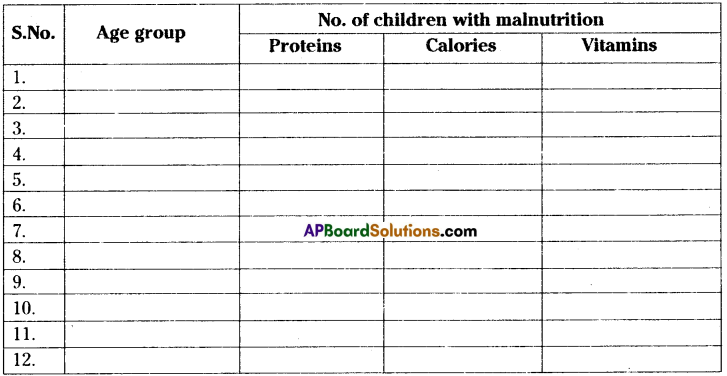
Question 25.
Would the survival of organisums become difficult. if there are no green plants on the earth? Why/Why not?
Answer:
- Plants play the most important part in the cycle of nature.
- Without plants there could be no life on earth.
- Plants are the only organisms that can make their own food and all other living
beings directly or indirectly depend on plants for their food. - Moreover plants release oxygen into the atmosphere through photosynthesis. Oxygen is essential for the organisms to respire.
- Carbondioxide present in atompshere is utilised by plants.
- Hence without green plants, all life on the earth would come to an end.
![]()
Question 26.
Draw the labelled diagram of human digestive system? List out the parts where peristalsis takes place.
Answer:
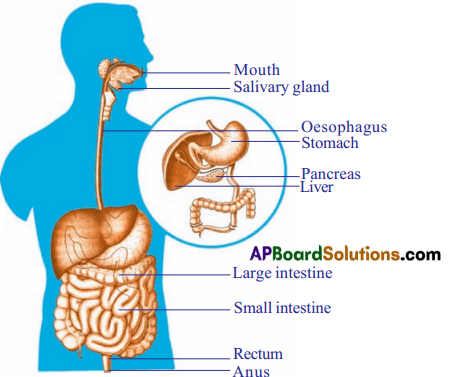
Parts where peristalsis takes place: Oesophagus, small intestine and large intestine.
Question 27.
Raheem prepared a model showing the passage of the food through different parts of the alimentary canal? Observe this and label it’s parts.

Answer:
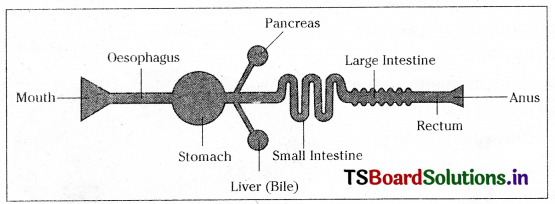
Question 28.
Observe the following diagram and write a note on light dependent, light independent reactions.
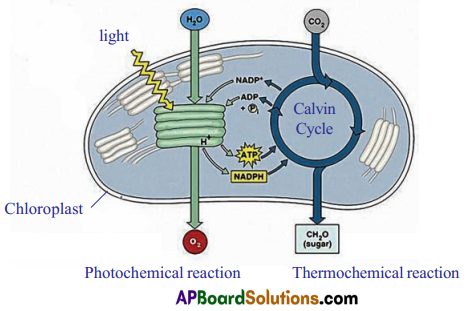
Answer:
1. Light dependent or Photochernical reaction : It takes place in chlorophyll containing thylakoids called grana of chloroplasts. It includes light absorption. Splitting of water lakes place, after series of reactions. Oxygen is released and the formation of high energy intermediates ATP and NADPH takes place.
2. light independent or Dark reactions: Dark reaction takes place in the stroma of chloroplasts. This reaction not depend on light. After many reactions NADPH is used to combine it with CO2, by utilising ATI energy and it produce glucose and finally get converted to starch.
![]()
Question 29.
What facts about the green plants do you appreciate?
Answer:
- Among all the living organisms on planet earth, only plants are capable of producing their own food and deriving energy from it.
- No other living creature can produce their food and thus depend on plants directly or indirectly.
- Through photosynthesis, plants take energy from the sun, carbon dioxide from the air and water, minerals from the soil. Then they give off water and oxygen.
- Plants are the primary producers that sustain all other life forms.
- Life without photosynthesis would thus be impossible.
Question 30.
What food habits will you follow after reading this chapter? Why?
Answer:
The food habits I am going to follow after reading this chapter are:
- I take balanced diet which contains proper amounts of carbohydrates. proteins, fats, vitamins and minerals.
- I avoid taking food containing high proportion of fat.
- I eat food as much required by my body. I do not over eat.
- I will not eat rich meals over several days.
- I eat simple balanced meals, eat it leisurely and thoroughly masticating the food.
- I avoid doing violent exercise soon after eating food.
- I empty the bowels regularly avoiding constipation.
- I will see to have plenty of roughages in the diet.
Fill in the blank
1. The food synthesized by the plant is stored as …………..
2. ………….. are the sites of photosynthesis.
3. The enzymes in the pancreatic juice help in the digestion of ………….. and …………..
4. The finger-like projections which increase the surface area in small intestine are called …………..
5. The gastric juice contains ………….. acid.
6. ………….. vitamin is- synthesized by bacteria present in intestine.
Answer:
1) carbohydrates
2)Chloroplasts
3) proteins, fats
4) Villi
5) HCl
6) Cyanocobalamine
Choose the correct answer
Question 1.
Which of the following organisms take the food by parasitic nutritIon?
i) Yeast
ii) Mushrooms
iii) Cuscuta
iv) Leeches
A) (i), (ii)
B) (iii)
C) (iii), (iv)
D) (i)
Answer:
B) (iii)
![]()
Question 2.
The rate of photosynthesis is not affected by [ ]
A) Light intensity
B) Humidity
C) Temperature
D) Carbon dioxide concentration
Answer:
B) Humidity
Question 3.
A plant Is kept in dark for about forty eight hours before conducting any experiment on photosynthesis in order to [ ]
A) Remove chlorophyll from leaves
B) Remove water from leaves
C) Ensure that no photosynthesis occurred
D) Ensure that leaves are free from the starch
Answer:
B) Remove water from leaves
Question 4.
The digestive juice without enzyme is [ ]
A) Bile
B) Gastric juice
C) Pancreatic juice
D) Saliva
Answer:
A) Bile
Question 5.
In single celled animals, the food Is taken by [ ]
A) Body surface
B) Mouth
C) Teeth
D) Vacuoles
Answer:
A) Body surface
Question 6.
Which part of the plant takes in carbon dioxide from the air for photosynthesis?
A) Root hair
B) Stomata
C) Leaf veins
D) Sepals
Answer:
B) Stomata
TS 10th Class Biology 1st Lesson Nutrition Intext Questions
1 Mark Question and Answers :
Question 1.
Can you name some raw materials needed for photosynthesis ?
Answer:
The external factors like sunlight and carbon dioxide and internal factors like water and chloroplasts are the raw materials needed for photosynthesis.
![]()
Question 2.
What could he the end products of the process of photosynthesis ?
Answer:
Glucose, water and oxygen are the end products of photosynthesis.
![]()
Question 3.
Do you think sunlight has a role in formation of starch ?
Answer:
Yes. Glucose is what is stored as starch in the mitochondria which is broken down later as energy. It is believed that most plants need sunlight, CO2, chlorophyll and water to produce starch.
Question 4.
What are the materials essential for the synthesis of carbohydrates in the process of photosynthesis ?
Answer:
The materials essential for the synthesis of carbohydrates in the process of photosynthesis are carbon dioxide, water, sunlight and chlorophyll.
Question 5.
Do you think the equation tells us about all the materials involved ?
Answer:
Yes, the materials which are essential for photosynthesis and the products formed are involved in the equation.
Question 6.
What had Priestly done to introduce the mint plant without disturbing the experiment set up ?
Answer:
For the continuity of oxygen in the bell jar Priestly introduced the mint plant. Because plants release oxygen in photosynthesis.
Question 7.
What precautions do you need while removing test tube from the beaker. Discuss with your teacher.
Answer:
When sufficient gas is collected, lift the test tube from the beaker by closing its mouth with the thumb so that the gas present in the test tube cannot escape into the atmosphere.
Question 8.
Which part of leaf turns bluish black ? What about the remaining part ?
Answer:
The part of the leaf, which could get light through the cut out design turns blue black showing the presence of starch.
The remaining part which did not get light, did not turn blue, indicating that starch is not prepared.
Question 9.
Observe the colour of leaf stained with iodine. Can you tell why it is stained differently?
Answer:
The leaf stained with iodine turns blue black. Starch is tested using iodine reagent. Appearance of blue colour on treatment with iodine reagent indicates the presence of starch.
Question 10.
What about plants having coloured leaves ?
Answer:
Plants having coloured leaves also carry photosynthesis.
Question 11.
How is that new leaves which look dark red in colour in several plants turn green ?
Answer:
Chloroplast is a definite structure containing different types of pigment molecules organized into pigment system.
Question 12.
Do plants having reddish or yellowish leaves also carry out photosynthesis ?
Answer:
Yes, chlorophyll is one among the several other pigments present in chloroplast. All these pigment molecules, including chlorophyll, are required for photosynthesis.
![]()
Question 13.
Where is chlorophyll and other pigments present in the plant ?
Answer:
Chlorophyll and other pigments are present in the grana thylakoids of chloroplast.
Question 14.
What happens to the food once it enters our body ?
Answer:
Food gets digested in the digestive system.
Question 15.
Name the enzymes which act on carbohydrates.
Answer:
Amylase or Ptyalin.
Question 16.
Which juice contains no enzymes ?
Answer:
Bile juice contains no enzymes.
Question 17.
What are the end products of fats ?
Answer:
The end products of fats are fatty acids and glycerol.
Question 18.
What are the enzymes that act on proteins ?
Answer:
Pepsin, Trypsin and Chymotrypsin.
Question 19.
What do you think about the necessity of the process of digestion ?
Answer:
The process of digestion occurs in the alimentary canal or digestive system. During the process of digestion large complex macro molecules present in the food are converted to simple and small molecules. Digestion provides the food material properly absorbed by the body.
Question 20.
What are the major steps of digestion ?
Answer:
The major steps of digestion are
- ingestion
- digestion
- absorption and
- defecation.
2 Mark Question and Answers :
Question 1.
How did Priestly light the candle from outside ?
Answer:
When the candle stopped burning in the bell jar, he placed a mint plant inside the jar. He found that the mouse stayed alive and the candle continued to burning when introduced a lighted candle.
By this experiment it is proved that plants can create oxygen, allowing fire to burn and animals to breathe.
![]()
Question 2.
Do you find any relationship between candle, rat, mint plant ? Discuss.
Answer:
Priestly’s experiment confirmed that gaseous exchange was going on and plants were giving out a gas that supported burning and was essential for the survival of animals.
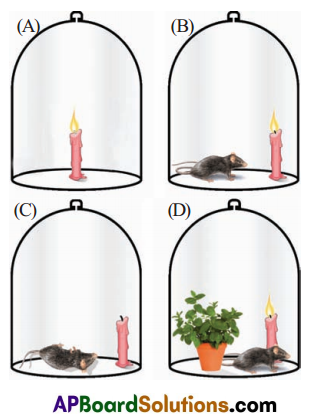
By combustion process candle releases carbondioxide. In respiration process rat also releases carbondioxide.
In photosynthesis process mint plant uses this carbondioxide and releases oxygen.
This oxygen will be used by rat to stay alive and for the candle to burn. So there is a relationship between respiration and photosynthesis by candle, rat and mint plant.
Question 3.
Why was the plant kept in dark and then in sunlight ?
Answer:
The plant is kept in the dark because we need a destarched plant to start with for the experiment.
For destarching the plant is kept in the dark for nearly a week to remove the starch from the leaves. Then only we can understand that the starch is prepared in the leaves or not after the experiment when the plant is kept in the sunlight.
Question 4.
Why did we test two leaves in this (Carbondioxide is necessary for photosynthesis) experiment ?
Answer:
The leaf which is exposed to the atmospheric air becomes bluish black. It proves starch is prepared in the leaf by using CO2 from atmosphere.
The leaf inside the flask containing potassium hydroxide, which absorbs CO2 present in the bottle does not become bluish black showing that carbon dioxide is necessary for photosynthesis.
Question 5.
What made plants carry out photosynthesis while even green coloured animals (like some birds) could not ?
Answer:
Chlorophyll and other pigment molecules trap (harvest) solar energy, convert it into chemical energy in the thylakoid membranes in chloroplast.
But animals having green colour on their body cannot trap solar energy and cannot perform photosynthesis.
Photosynthesis is possible only in plants but not in animals.
Question 6.
Try to name some parts where you think Photosynthesis occurs.
Answer:
Photosynthesis takes place inside plant cells in small things called chloroplasts. Chloroplasts (mostly found in the mesophyll layer) contains a green substance called chlorophyll. Below are the other parts of the cells that work with the chloroplast to make photosynthesis happen.
- Cell wall
- Cytoplasm
- Cell membrane
- Vacuole and
- Nucleus.
![]()
Question 7.
Do you think the new reddish leaves of plants also carry out photosynthesis ?
Answer:
Chlorophyll is one among the several other pigments present in chloroplasts. All these pigment molecules, including chlorophyll, are required for photosynthesis. These different molecules are arranged in a specific manner facilitating the process of photosynthesis. The reddish leaves of plants also carry out photosynthesis.
4 Mark Question and Answers :
Question 1.
Collect information about pellagra and discuss with your teacher.
Answer:
Pellagra is the disease caused by decrease intake of Niacin or Tryptophan, Vitamin – B3 and possibly by excessive intake of Leucine.
It may also result from alternation in protein metabolism in disorders such as carcinoid syndrome or Hartnup disease. A deficiency of the amino acid lysine can lead to deficiency of Niacin as well.
Symptoms : Pellagra is described by 3 Ds – Diarrhoea, Dermatitis, Dementia
A more comprehensive list of symptoms include
- Sensitivity to sunlight
- Aggression
- Dermatitis
- Alopecia (hair loss)
- Edema (swelling)
Smooth, beefy red, glossitis, red skin lesions, insomnia (sleepless), weakness, mental confusion, nerve damage are the symptoms of this pellagra:
Prevention : By taking of yeast, meat, fish, milk, eggs, green vegetables, beans and cereal grains, we can prevent this disease.
TS 10th Class Biology 1st Lesson Nutrition Activities
Activity – 1.
To prove that carbon dioxide is necessary for photosynthesis by Mohl’s half leaf experiment, what procedure do you follow in the laboratory?
OR
List out the materials required and the procedure to be followed to prove that “Carbon dioxide is essential for Photosynthesis”.
Answer:
Aim : To prove that carbon dioxide ¡s essential for photosynthesis by Mohi’s half-leaf experiment.
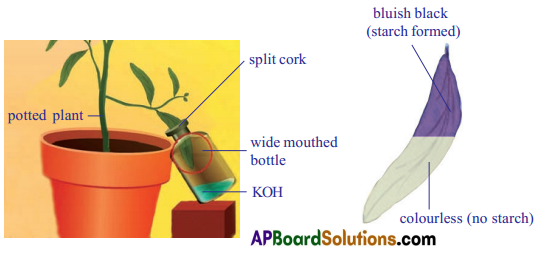
Apparatus: Wide mouthed bottle, potassium hydroxide (KOH) solution, potted plant, vertically split cork, Iodine solution, Wax.
![]()
Procedure : Arrange the apparatus as shown in the figure.
- Take a potted plant and keep ¡tin the dark for nearly 3-4 days for the removal of starch from the leaves.
- Take a wide mouthed transparent bottle.
- Pour potassium hydroxide solution in the bottle.
- Potassium hydroxide absorbs carbon dioxide in the bottle.
- Insert splitted cork in the mouth of the bottle.
- Insert one of the leaves of destarched plant through a split cork into transparent bottle containing potassium hydroxide pellets or potassium hydroxide solution.
- Apply wax or grease to split cork so that, CO2 will not enter into the bottle.
- Leave the plant n sunlight.
- After a few hours, test this leaf and other leaf of this plant for starch.
Observation:
- The part of the leaf outside the bottle turns to bluish-black because starch is formed in that part due to
- The part of the leaf inside the bottle does not turns to bluish-black because the carbon dioxide present inside the bottle is absorbed by potassium hydroxide solution.
Result : This experiment proves that CO2 is necessary for photosynthesis.
Precautions:
- The part of the leaf kept inside the bottle should not touch potassium hydroxide solution.
- The apparatus should be kept air tight by applying grease or vaseline.
Activity – 2.
Prove that sunlight is necessary to form starch in green plants.
OR
To prove that sunlight is essential for photosynthesis for this.
i. What apparatus required
ii. What procedure will you follow
iii. What are your observations?
OR
Write the materials required and the procedure to prove that light is essential for Photosynthesis.
OR
Write the procedure, precautions and observations in the lab activity, “Sunlight is necessary for photosynthesis ‘.
Answer:
Aim : To prove that sunlight is necessary for photosynthesis experiment.
Apparatus : Potted plant, light screen, iodine solution, petridish, black paper.
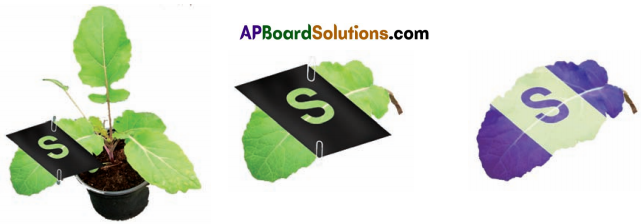
Procedure :
- Take a potted plant and destarch it by keeping in the dark for 3-4 days.
- Cover one of its leaves with black paper on which a design is cut on both sides of leaf.
- Fix the paper on the leaf in such a manner that light does not enter the dark part.
- Place this plant in the sun for few hours.
- After few hours of exposure to bright sunlight, test the leaf which is covered by black paper for the presence of starch.
Observation : It will be observed that only the parts of the leaf, which could get sunlight through the cutout design, turns bluish black showing the presence of starch. Result; This experiment proves that light is necessary for photosynthesis.
![]()
Activity – 3.
Observe different digestive enzymes and their role in digesting food.

Answer:
